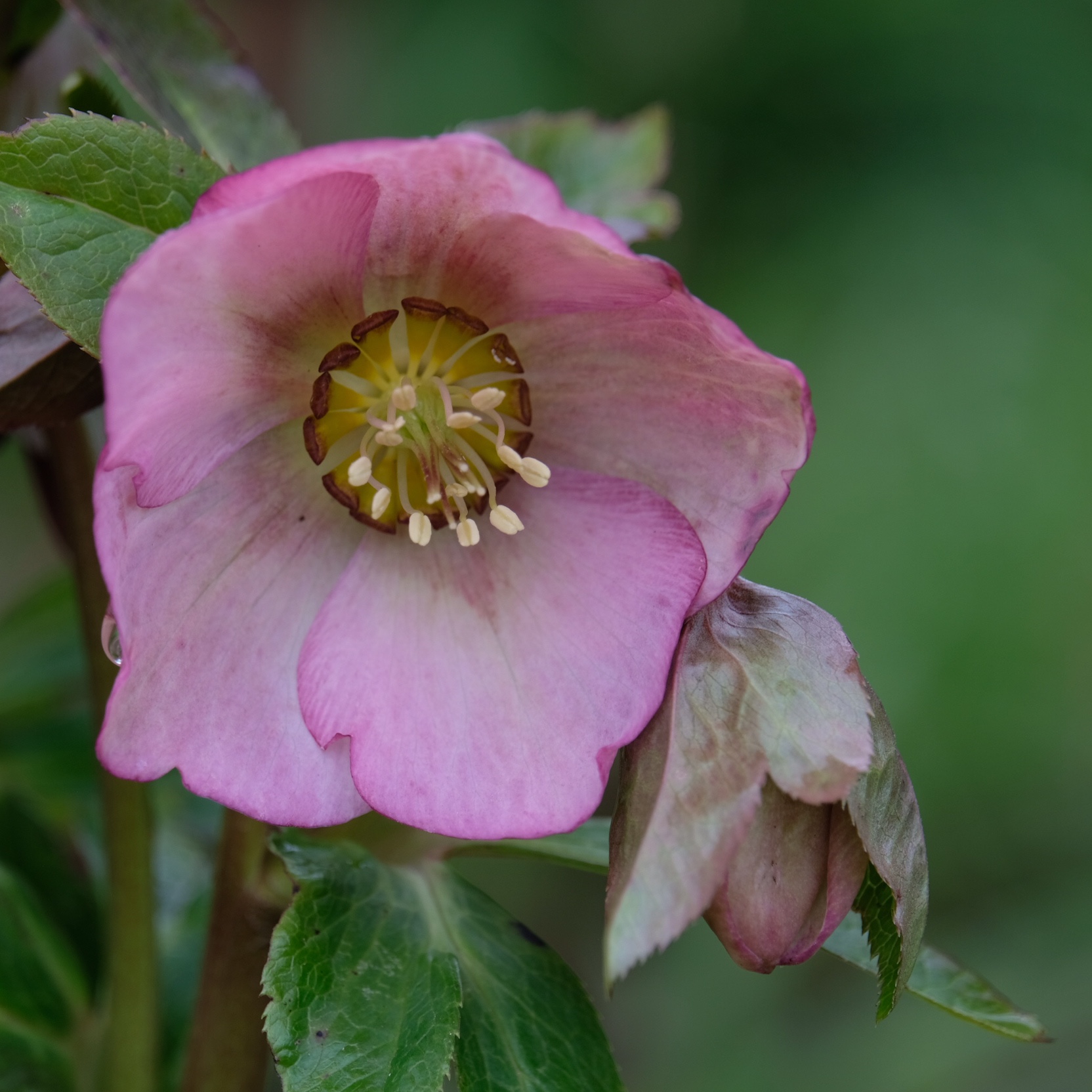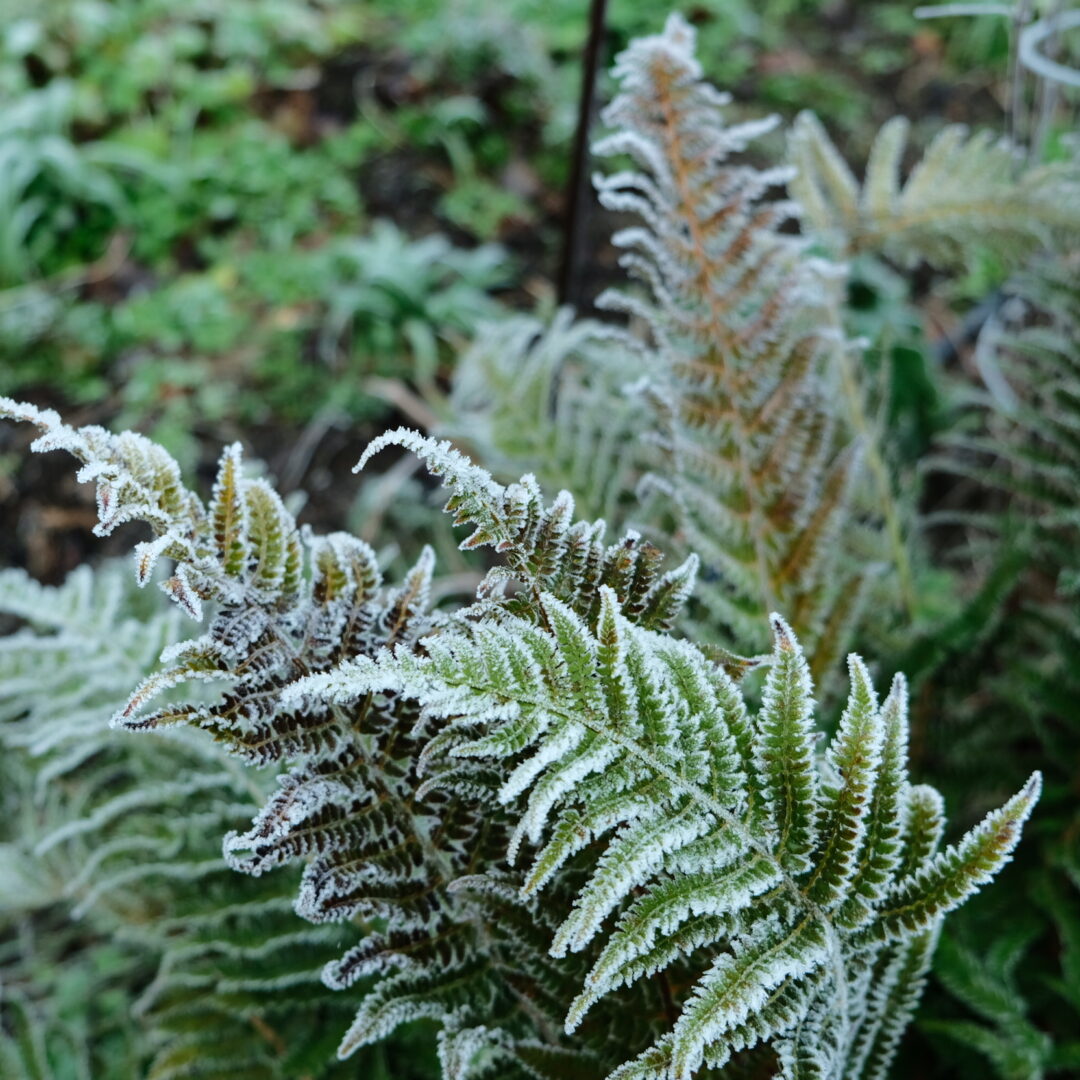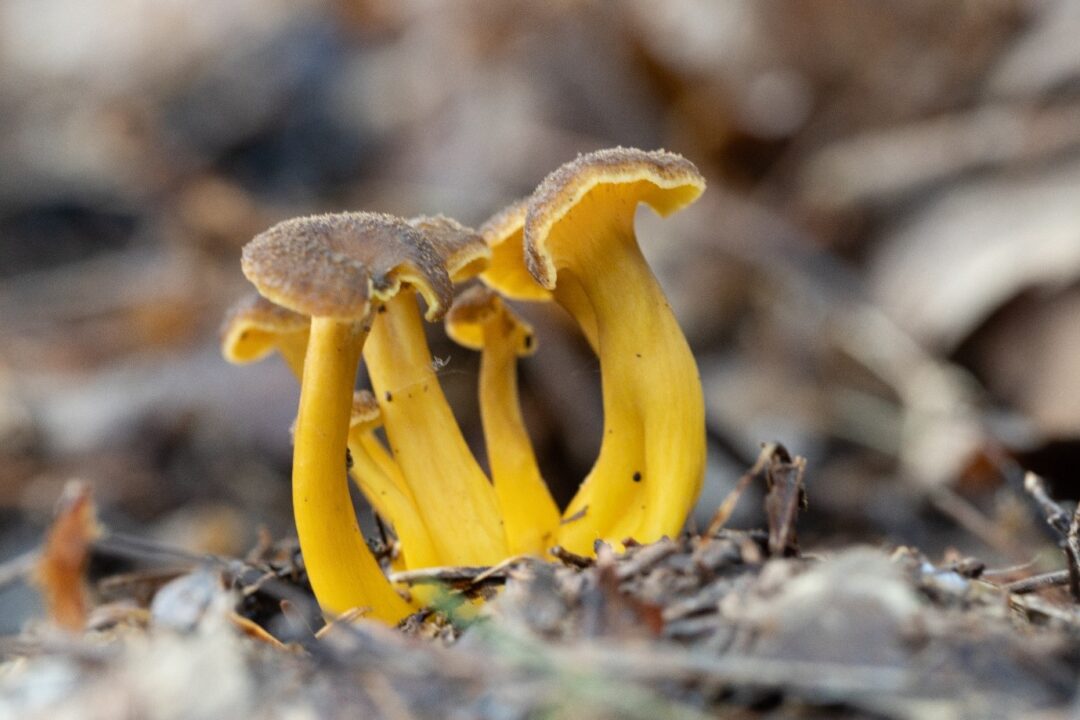January 4th, 2023
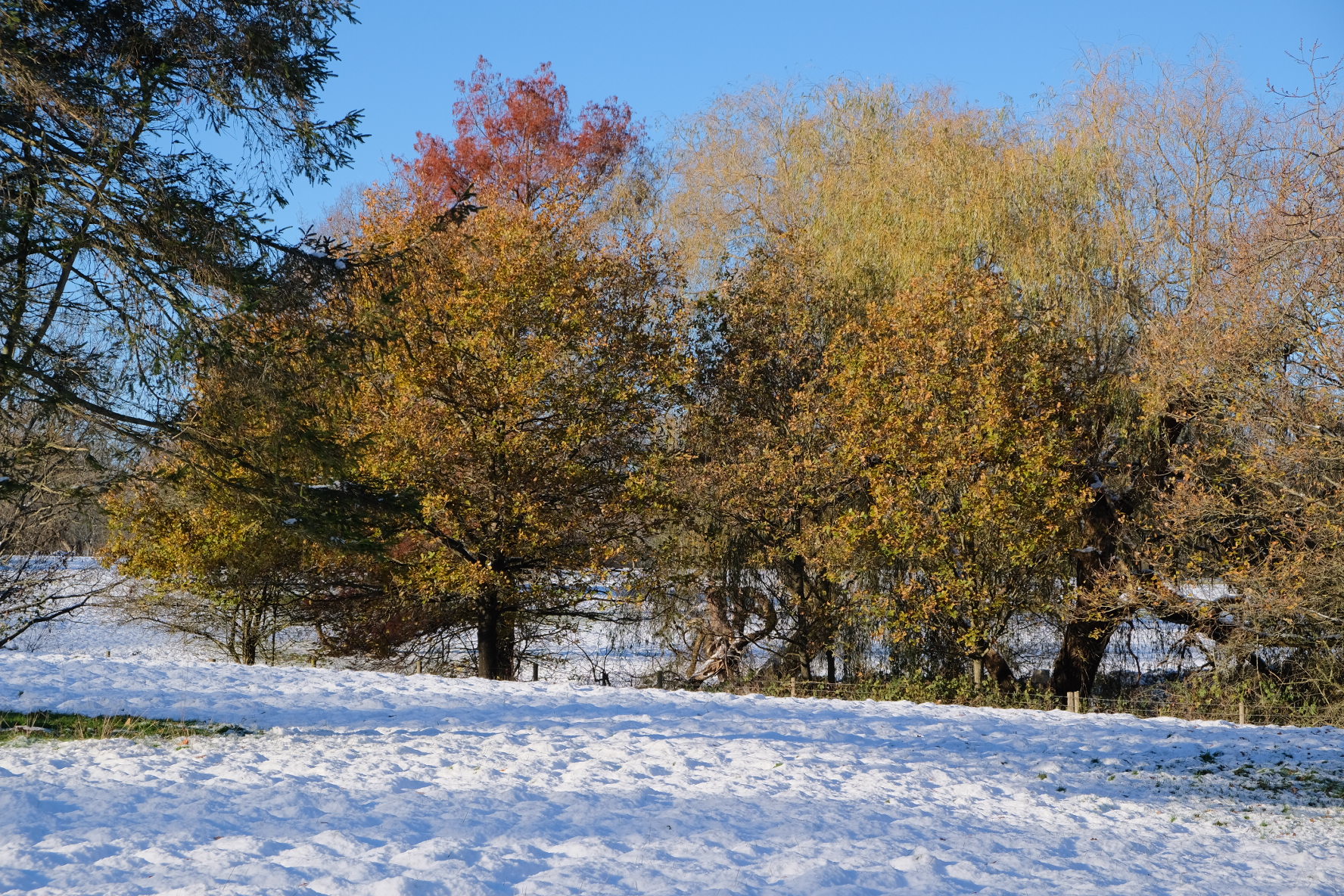
A Snowy Scene of Morghew
‘Morgengiefu appears on Modern maps as Morghew Farm. It is derived from the ” morgen giefu ” of Saxon custom, the dower gift to a wife on the morning after the wedding. This custom may have survived the conquest but I find it difficult to believe that the altered conditions of landownership amongst the higher classes would have allowed a new holding to grow up and to attach to itself this very characteristic Saxon name.’ (Gordon Ward, ‘Saxon Records of Tenterden)
There is a magic in names that can be traced back across the year, and this one reminds us of a past culture and ‘women’s lands’.
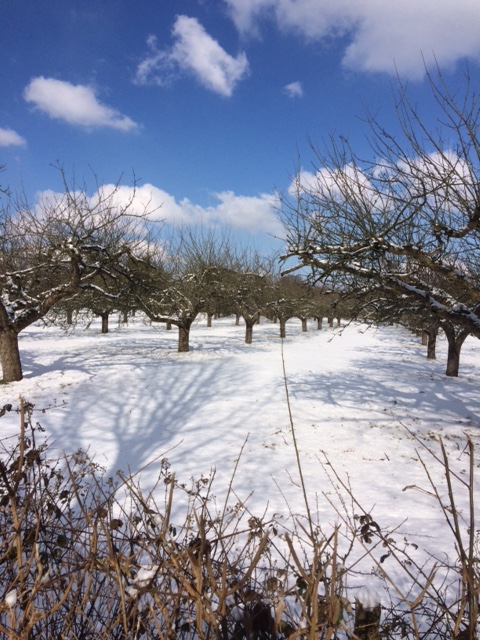 This second photograph, taken by Phil Reeves, is of the orchard at Hales Place and captures the coldness of the winter week that we have so recently experienced.
This second photograph, taken by Phil Reeves, is of the orchard at Hales Place and captures the coldness of the winter week that we have so recently experienced.
The pruning is an exacting art and one that is passed down through the generations.
Most gardens are looking as though they are a bit bashed by the weather and the weight of the snow. That familiar fear that plants that have been mainstays in the garden for years might not recover the cold and the inundation; yet as I squelch up the garden to check that the shed is still standing, there are bulbs poking their heads up. A particularly robust Allium schubertii is well above ground with its friend. They are both sheltered by the shed and a vigorous Anemanthele lessoniana that self seeds in the most unexpected places. The borage, a mere foot away, that had come up late and decided to stay flowering in all the autumn mildness had become mush.
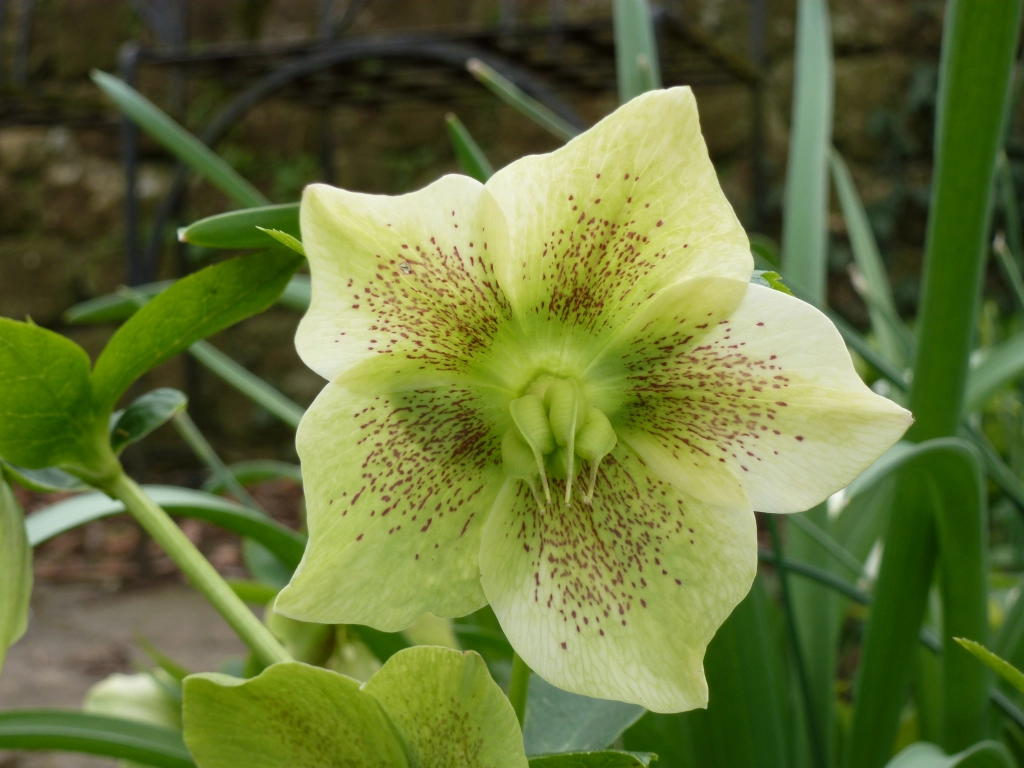
A plant that is just beginning to come into its own in the garden is the Hellebore. These belong to the family Ranunculaceae. They like semi-shade and well-drained soil. They do self seed, and the seedlings develop into the most wonderful hybrids, some much more flamboyant than their parents. They can also be propagated by division. Beautiful and uplifting though they are at this time of the year, the sap can cause skin irritation and the ingestion of any part of the plant will cause severe discomfort.
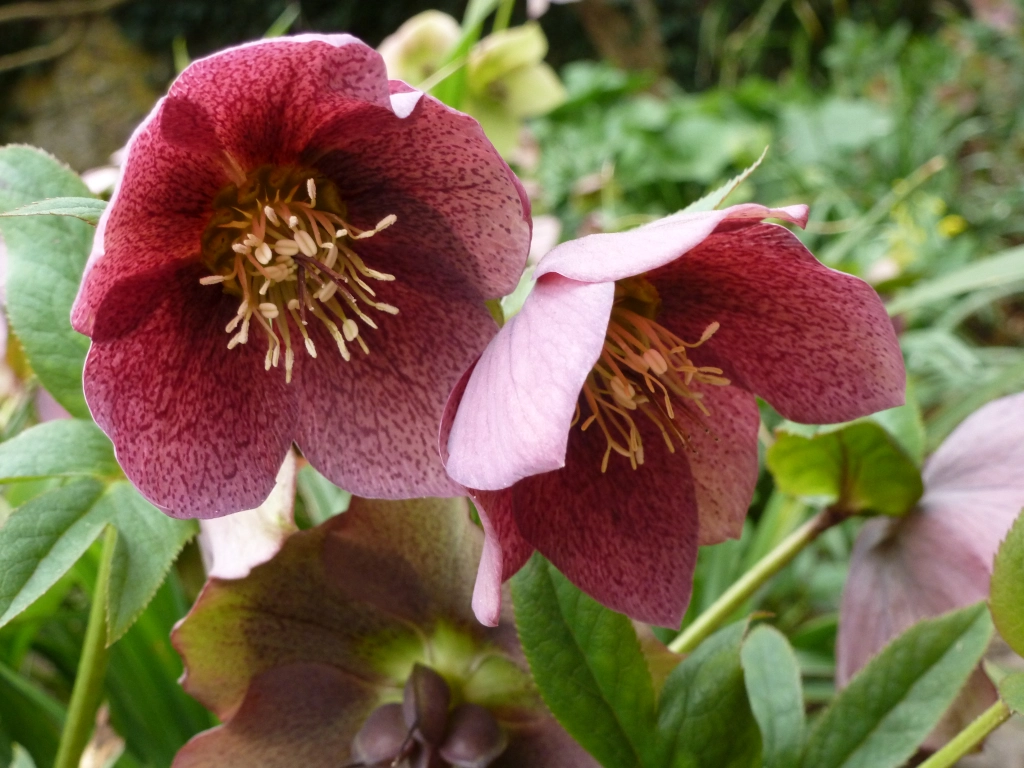
The two native species of Hellebore – green hellebore and stinking hellebore – are both toxic, but they were used in herbal remedies. The plants were used for purges to get rid of intestinal worms, but their action was so fierce and sometimes even fatal that the practice was discontinued. As Gilbert White observed, ‘Where it killed not the patient it would certainly kill the worms; but the worst of it is, it will sometimes kill both’. (Hatfield’s Herbal)

The Christmas rose, also extremely toxic, was used to treat gout, jaundice, sciatica and leprosy. Nicholas Culpepper in 1653 wrote that the antidote for poisoning with Hellebore is to drink goat’s milk. It is a beautiful but dangerous plant. (Hellebore dried and beaten with cumin was used as a remedy for fleas, ticks and lice in dogs.)
‘In early modern Europe, a medical prescription of hellebore carried immediate and powerful significance. Since ancient times, it was implicitly understood that to be given hellebore was to be declared mad and therefore beyond the power of most ordinary medicines. The Latin idiom “O caput elleboro dignum” (O head, worthy of hellebore) attained proverbial status in sixteenth- and seventeenth-century Europe, and the plant’s near-miraculous virtues in cases of mental illness were documented by some of the most influential medical writers of the age.’ To read more of this article about follow this link: https://www.cambridge.org/core/journals/journal-of-british-studies/article/that-they-may-vomit-out-their-folly-the-gutmind-axis-and-hellebore-in-early-modern-england)
In folklore it was considered good luck to grow Hellebores in the garden, but the plant was also associated with witches. The Greek helleborus translates as ‘injure food’ alluding to its poisonous properties. A legend about the Hellebore was that it sprung form the tears of a young girl who had no gift to give to the Child Christ.
In the language of flowers a Hellebore meant scandal, madness, serenity or hope. There is a very good paper on the language of flowers that can be found here: https://www.rhs.org.uk/about-the-rhs/pdfs/publications/lindley-library-occasional-papers/volume-ten.pdf
All in all, beautiful to look at, but definitely not to be ingested.
Dipping into History – Roman Gardens

The earliest records of gardens in England are of Roman gardens. Given that so many finds at Smallhythe this past digging season (2022) date from that era, it seems appropriate to consider Roman gardens in this county, and the influence that they had on the ecosystem.
The period between 500 BC and AD 1000 was wet and cold. Tacitus, a renowned Roman historian and public figure – who was married to the daughter of Gnaeus Julius Agricola, wrote of Britain’s climate that it was unpleasant with ‘frequent rain and mist’ but that there was no severe cold. The soil was fertile and suitable for most crops. (Agricola was governor of Britain between AD 77 to 85.)
Lullingstone, Eccles and Darenth are all sites in Kent where Roman villas have been discovered. At Darenth Court farm there are signs of occupation dating from prehistoric times to the present including, Roman and Anglo-Saxon finds.
Nearer to Tenterden is the site at West Hawk farm in Ashford. There the ‘remains of a polygonal timber shrine [was]… discovered … on the north-eastern side of the Roman Weald-Canterbury road. Votive coins were recovered from a nearby well…artefacts from the shrine itself included a fragment of cone from the Stone Pine (pinus pinea), a Mediterranean species particularly associated with temple sites. It is thought that the Stone Pine was not grown in Britain until about AD 1500, and the cone was therefore imported into Roman Britain by way of trading links with the Continent. In Roman religion, the pine tree was sacred to the fertility goddess, Cybele, and symbolises the immortality of nature and the cycle of the seasons’.
One of the legacies of the Roman invasion were the plants that they introduced, some of which became established. One wonders whether any of the people who owned the finds discovered at Smallhythe were gardeners?
Introduced species of plants were: the English walnut, the apricot tree, the mulberry tree, grape vines, cabbage, onions, ground elder, fennel, Rosa gallica and others. the sweet chestnut (although this is now being questioned because no pre AD 650 finds could be found in the archaeobotanical record apart from some pips that might have been part of a Mediterranean trader’s meal).
Juniper and box were used for hedging. Acanthus, crocus, pansy and roses would be grown in the gardens as would plants of medicinal value.
The following plants were identified as being cultivated at Chedworth: thyme, mint, basil, bay, hyssop, plum, apple, pear, damson.
At Silchester, archaeologists found evidence of: garlic, rhubarb, lettuce, cabbage and cucumber as well as St John’s wort, coriander, plantain, geraniums, marigolds, poppies and box.
Fishbourne in Chichester had a well laid out garden with fruit trees, topiary, colonnades, fountains and roses.
Roman gardeners were skilled plantsmen. They practised grafting and layering, used manure, mica sheets for cold frames, pesticides, and they also fumigated their orchards.
The villa garden would have a specialist for vegetable husbandry, a specialist for trees, a specialist for shrubs. Pruning hooks, wooden spades with metal shoes to give a good cutting blade, sickles, hatchets, knives, rakes were all tools that would have been used.
Vineyards were established in spite of Tacitus’ concerns about the weather being too cold, the temperature may have been warming up as by AD 270 restrictions on British wine production were lifted by Imperial Edict.
In Smallhythe today, Chapel Down has its productive vineyard with over 950 acres ‘under vine’.
New feet within my garden go –
New fingers stir the sod –
A Troubadour upon the Elm
Betrays the solitude.
New children play upon the green –
New Weary sleep below –
And still the pensive Spring returns –
And still the punctual snow!
Emily Dickinson

